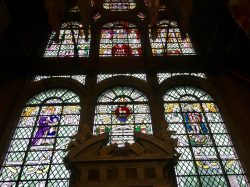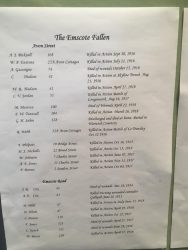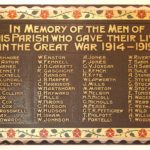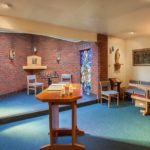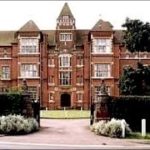The Town Remembers
The Warwick casualties of both World Wars are commemorated in many places around the town as well as on the war memorial in Church Street. The churches honour members of their congregations; many schools keep records of ‘old boys’ who went off to serve and didn’t return, and some have erected honour boards.
The Churches
Many of the town’s churches keep records of members of their congregations who volunteered to fight in WWI or were called up in WW2. Some have the initials KIA next to their names – meaning Killed In Action. St. Mary’s honours all the members of the Royal Warwickshire Regiment who went off to war and did not return.
The Collegiate Church of St. Mary
The Royal Warwickshire Regimental Chapel in the north transept honours The Fallen from this famous infantry regiment who served in both world wars and earlier conflicts around the world. In The Great War the regiment served with particular distinction on the Western Front in harsh conditions, losing more than eleven and a half thousand men. In WW2 battalions served in Europe including the D-Day landings and the Italian campaign, the Middle East and the Far East including the Burma Campaign.
The chapel was dedicated in 1952 when a stained glass window designed by Philip Chatwin was unveiled. It was inspired by the idea of the souls and personalities of the fallen being conveyed to heaven by angels. A book listing all those from the RWR who died in the 1939-45 war is available for relatives.
Between the chancel steps and the south transept there is a marble and alabaster memorial to those from the RWR who died in WWI. It has a book of remembrance listing all the 11,610 names of the fallen. A page is turned daily and the church welcomes relatives seeking a loved one’s name.
In the autumn of 2018, a huge display of poppies made by local groups and individuals from felt, card, metal or wool decorated the interior of the church to mark the centenary of the WWI Armistice.
Members of the Warwickshire Yeomanry are remembered on a brass tablet at the front of the church, and a plaque attached to one of the pillars in the nave commemorates the men of the Warwickshire Royal Horse Artillery who died on the Western Front during WW1.
St. Nicholas Church
Standing opposite the South Gate of the Castle, and regarded historically as the castle’s church, the present St. Nicholas Church was built in 1785 on the site of an old medieval chapel. It is a rare example of Gothic Revival style.
The St Nicholas Roll of Honour board for WWI is crafted in wood and bears 78 names of the fallen of the parish. It is situated in what is known as the ‘Lower East End’ of the church and can be accessed via a large wooden door at the back of the building.
The citation on the roll of honour board reads: ‘1914-1919. Remember with Thanksgiving the Men who in These Years of War went forth from this Parish and gave their lives for God and their Country’.
 There is also a rather splendid bronze plaque surmounted by a grieving angel, ‘In loving memory of Lieutenant Edward Victor Humphriss’.
There is also a rather splendid bronze plaque surmounted by a grieving angel, ‘In loving memory of Lieutenant Edward Victor Humphriss’.
He was a St. Nicholas parishioner who served with the Northamptonshire Yeomanry.
The plaque says he volunteered to serve his country on September 3rd 1914 and was killed in action on April 11th 1917 at Monchy-Le-Preux in France, aged 28 years.
St. Paul’s Church
St. Paul’s in Friar Street on the west side of town is in an area that once housed the workers in the industries that sprang up after the development of the Grand Union Canal. There are 75 fallen from the First World War from the parish of St. Paul’s; many lived in the immediate area of Crompton Street, Woodhouse Street, Stand Street, Queen’s Square and West Street.
 The fallen from the parish are commemorated in the church on a Roll of Honour Board. The inscription above the WW1 names reads: ‘To the Glory of God and in memory of the men who fell in action or died on duty from St. Paul’s parish and congregation from August 1914 to November 1918.’ The WW2 board reads, ‘In grateful memory of those men from St. Paul’s Parish and Congregation who died for their King and Country 1939-1945’.
The fallen from the parish are commemorated in the church on a Roll of Honour Board. The inscription above the WW1 names reads: ‘To the Glory of God and in memory of the men who fell in action or died on duty from St. Paul’s parish and congregation from August 1914 to November 1918.’ The WW2 board reads, ‘In grateful memory of those men from St. Paul’s Parish and Congregation who died for their King and Country 1939-1945’.
Above it is a poppy tapestry that includes a poppy for each person remembered and the year in which they died. Below is a display showing details of various conflicts as well as a folder with personal information about each of the names.
St. Paul’s also has a commemorative window dedicated to WWI. The bottom section includes a tribute to William Hensley who was killed in 1918. William’s father, Rev. Henry Gabriel Hensley, was the vicar of St. Paul’s between 1887 and 1908.
Following a special service on Armistice Day, 11th November, members of the St. Paul’s congregation carried the Poppy Tapestry in a procession to the Warwick War Memorial.
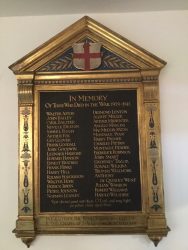
All Saints’ Church, Emscote
WW2
There are 38 names of those connected with All Saints’ Church who died in WW2, and are commemorated on an elegant roll of honour board. It was erected at a special service in 1951.
WW1
The 60 parishioners and relatives of congregation members who died in WW1 are commemorated on a separate board mounted on the wall of the Lady Chapel.
To mark the 100th anniversary of The Armistice, the ‘Emscote History Project’ put together a display in All Saints’ Church with the names of the men from Emscote Road, Avon Street and the neighbouring streets who did not return from the war. There were also some fascinating artefacts from the war years including an early gas-mask and a pack of Christmas gifts for a soldier on the Western Front. [Photos provided by Kathleen Smallman]
On November 11th, the congregation marked the Armistice Centenary by reading out, at their morning service, the names of the sixty parishioners who died in WW1.
[Photos by David Hawkins] All Saints also sounded a bell which has not been rung for many years. The bell came originally from HMS Renown, a ship which was commissioned in 1915 and decommissioned in 1948. A curate at All Saints had been in the Royal Navy and asked the Admiralty to donate the bell, which they duly did.
The old church at All Saints was knocked down in 1967 because it was deemed unsafe and the congregation moved to the Mission House (now also demolished) and then to the old infant school, now the church Contact Centre. The new church was consecrated in 1989. The bell was used at the Mission House but has not been rung since the new church was built. This was remedied on Remembrance Sunday 2018. The church has been raising funds to commission a portable stand for the bell from John Taylor & Company of Loughborough, so that the bell – which is extremely heavy – can be moved into place when required.
The Northgate Methodist Church
Formerly the Warwick Wesleyan Chapel, the Methodist Church has an honour board with the names of those from the congregation who served in the Second World War, and their archivist is now planning to erect another board with the longer list of names (at least 36) of those from the church who served in the 1914-18 war.
The Museums
The Fusilier Museum, housed at the time at St John’s (now found at Pageant House, Jury Street, Warwick) https://fusiliermuseumwarwick.com/ tells the story of the Royal Warwickshire Regiment from its origins in 1674.
The Warwickshire Yeomanry Museum in the basement of the Visitor Centre, Jury Street, Warwick – https://www.warwickshire-yeomanry-museum.co.uk/ has many details of the volunteer cavalry regiment and the Royal Horse Artillery that served on the Western Front and in the Middle East in WW1.
The Queens Royal Hussars – this recently opened museum can be found at Trinity Mews, Priory Road, in the centre of Warwick. It showcases the history of the regiment from 1685 to the present day – https://www.qrhmuseum.com/
Local Schools
Many of Warwick’s schools have either honour boards or archived records of the former pupils who died in The Great War.
Warwick School lost no fewer than 90 old boys over the course of the First World War, many of them officers. Their names are commemorated on an honour board in an extension to the school chapel.
The inscription reads: This extension of the Chapel consisting of Gallery and Vestry has been erected in the memory of Old Warwickians who lost their lives in the service of their country during the Great War – 1914-1918. Above is the school crest and motto, Altiora Peto, (I seek higher things).
The school is a member of the First World War Centenary Partnership with the Imperial War Museums. In November 2016 the school screened the UNESCO listed film The Battle of the Somme, before a special Remembrance Day service for the eighteen old boys who died in that battle.
Coten End School is the largest primary school in Warwickshire, dating back to 1884. There was a Roll of Honour in the school hall for former pupils who had died in both World Wars. But in 1951 a fire destroyed six classrooms and the main hall, and the wooden honour board is thought to have been lost.
 Other Memorials
Other Memorials
In St. Nicholas Park near the Leisure Centre, there is a memorial stone with the names of seventeen of the fallen; fourteen of them died in the First World War and three in WW2. Why are those particular names commemorated? After we appealed for information, local military researcher David Oliver came up with the answer. He wrote:
“The Warwick Advertiser on Saturday January 28 1933 carries a report of an application from the Earl of Warwick Lodge of the Order of Druids to plant a memorial avenue of trees in the newly created St Nicholas Park. The Borough Council extended the ability to plant a memorial to any local citizen on the payment of 25 shillings which covered the cost of the trees (specifically purple beech), the planting and a memorial plaque. Advertisements featured in later editions of the paper and there are reports of the unveiling of memorial stones later in the year.
 The answer to your question as to why those names were commemorated would seem to be because they were members of the Order of the Druids or had surviving relatives who could afford the 25 shillings to purchase a memorial tree.
The answer to your question as to why those names were commemorated would seem to be because they were members of the Order of the Druids or had surviving relatives who could afford the 25 shillings to purchase a memorial tree.
There are some later additions to the plantings which involved members of the local branch of the British Legion and servicemen who lost their lives in the second world war.
At the beginning of the centenary period of WW1, I approached Warwick District Council to restore the plaques that were deteriorating at the base of each of the trees – however they chose to place the memorial stone and plaque that you have featured on your website”.
David has found the record of a survey by the British Legion in 1983 listing the original memorial plaques with a hand drawn map of where each memorial tree was planted. So mystery solved. Thank you, David.
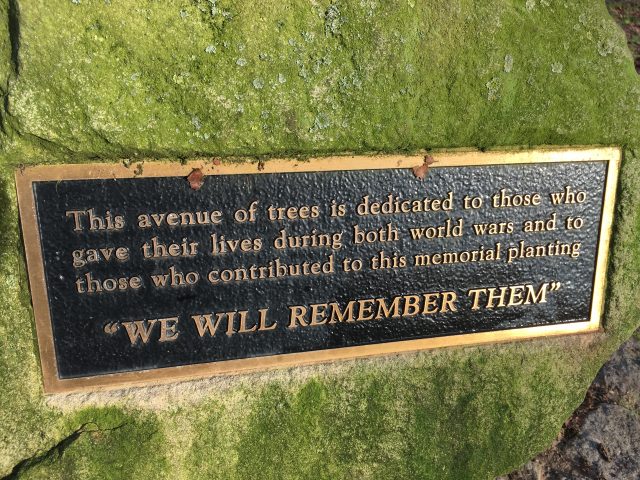
Warwick Poppies 2018
In 2018, for the Centenary of the end of the First World War in 1918, a spectacular display of poppies decorated the Collegiate Church of St. Mary. More information can be found on the Warwick Poppies 2018 page.

